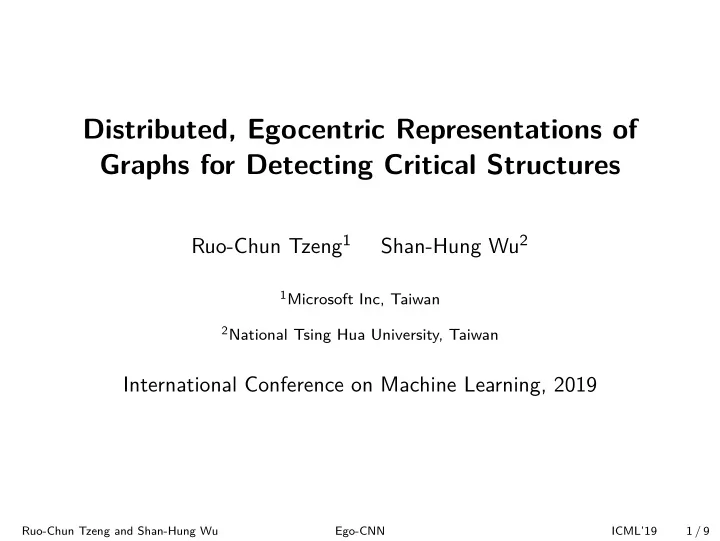

Distributed, Egocentric Representations of Graphs for Detecting Critical Structures Ruo-Chun Tzeng 1 Shan-Hung Wu 2 1 Microsoft Inc, Taiwan 2 National Tsing Hua University, Taiwan International Conference on Machine Learning, 2019 Ruo-Chun Tzeng and Shan-Hung Wu Ego-CNN ICML’19 1 / 9
Goal To learn representations of graphs by using convolutions Ruo-Chun Tzeng and Shan-Hung Wu Ego-CNN ICML’19 1 / 9
Goal To learn representations of graphs by using convolutions ...while keeping nice properties of CNNs on images: Filters detect location independent patterns Filters at a deep layer have enlarged receptive fields Ruo-Chun Tzeng and Shan-Hung Wu Ego-CNN ICML’19 1 / 9
Goal To learn representations of graphs by using convolutions ...while keeping nice properties of CNNs on images: Filters detect location independent patterns Filters at a deep layer have enlarged receptive fields ...and being able to detect critical structures Ruo-Chun Tzeng and Shan-Hung Wu Ego-CNN ICML’19 1 / 9
What are the critical structures? Local-scale critical structures, e.g., Alkane vs Alcohol Global-scale critical structures, e.g, Hydrocarbon Ruo-Chun Tzeng and Shan-Hung Wu Ego-CNN ICML’19 2 / 9
STOA: Graph Attention Networks (GAT) 1 The (1-head) GAT learns an attention score α ij for each edge ( i , j ) h ( l ) α ij Wh ( l − 1) � = σ + b i j j ∈N i α ’s explicitly point out the critical structures When jointly learned with a task, α ij denotes the contribution of edge ( i , j ) to the model prediction 1 P Veličković, G Cucurull, A Casanova, A Romero, P Lio, Y Bengio, Graph attention networks, ICLR’18 Ruo-Chun Tzeng and Shan-Hung Wu Ego-CNN ICML’19 3 / 9
Drawback: limited learning ability However, the (1-head) GAT suffers from limited learning ability α ij Wh ( l − 1) h ( l ) � = σ + b i j j ∈N i A filter W scans one node at a time does not capture the interactions between nodes Not a serious problem for node-level (e.g., classification) tasks But may severely degrade the performance of graph-level tasks Ruo-Chun Tzeng and Shan-Hung Wu Ego-CNN ICML’19 4 / 9
A new way: Ego-CNN Idea: to learn critical structures just like image-based CNNs h ( l ) α ij Wh ( l − 1) + b = σ � 1-head GAT (ICLR’18) i j j ∈N i W ⊛ � j ∈N i h ( l − 1) h ( l ) � � + b = σ Traditional Convolution i j h ( l ) W ⊛ � j ∈N i h ( l − 1) � � + b = σ Ego-Convolution (ours) i j For each node i , a filter W is applied to all nodes in the 1 neighborhood N i of i Use common visualization techniques (e.g., deconv) to backtrack 2 critical structures Ruo-Chun Tzeng and Shan-Hung Wu Ego-CNN ICML’19 5 / 9
Challenge: variable-sized N i makes W ill-defined h ( l ) � W ⊛ � j ∈N i h ( l − 1) � = σ + b i j For images, N i can be easily defined E.g., K × K pixel block centered at i But how to define N i for graphs ? Ruo-Chun Tzeng and Shan-Hung Wu Ego-CNN ICML’19 6 / 9
Challenge: variable-sized N i makes W ill-defined h ( l ) � W ⊛ � j ∈N i h ( l − 1) � = σ + b i j For images, N i can be easily defined E.g., K × K pixel block centered at i But how to define N i for graphs ? Solution: nodes that are most salient to the given task in a ego-network centered at i First layer: set N (1) as the top K unique nodes in 1 i Weisfeiler-Lehnman labeling Deep layers: N ( l ) = N ( l − 1) (just like image-based CNNs) 2 i i Ruo-Chun Tzeng and Shan-Hung Wu Ego-CNN ICML’19 6 / 9
Improved learning ability on graph classification In Ego-CNN, a W at layer l can detect node interaction patterns within l -hop ego-networks 1st layer 2nd 5th Ruo-Chun Tzeng and Shan-Hung Wu Ego-CNN ICML’19 7 / 9
Improved learning ability on graph classification In Ego-CNN, a W at layer l can detect node interaction patterns within l -hop ego-networks 1st layer 2nd 5th Graph classification benchmark datasets With K = 16, Ego-CNN is comparable to the state-of-the-arts Ruo-Chun Tzeng and Shan-Hung Wu Ego-CNN ICML’19 7 / 9
Ego-CNN can learn critical structures WITHOUT α Backtracking W with common CNN visualization techniques (e.g., deconv) reveals critical structures Local-Scale: Alkane vs Alcohol Global-Scale: Symmetric vs Asymmetric (a) C 14 H 29 OH (c) Symmetric Isomer (b) C 82 H 165 OH (d) Asymmetric Isomer Table: Visualization of the critical structures detected by Ego-CNN Ruo-Chun Tzeng and Shan-Hung Wu Ego-CNN ICML’19 8 / 9
More benefits... and let’s chat at Poster #22 Ego-CNN can detect self-similar patterns I.e., same patterns that exist at different zoom levels Commonly exist in social networks How? Ruo-Chun Tzeng and Shan-Hung Wu Ego-CNN ICML’19 9 / 9
More benefits... and let’s chat at Poster #22 Ego-CNN can detect self-similar patterns I.e., same patterns that exist at different zoom levels Commonly exist in social networks How? By simply tying the weights ( W ’s) across different layers For more details, please go to Poster #22 Ruo-Chun Tzeng and Shan-Hung Wu Ego-CNN ICML’19 9 / 9
Recommend
More recommend